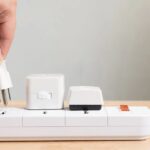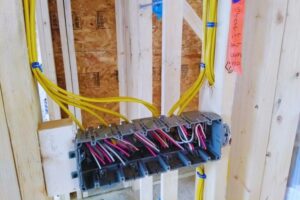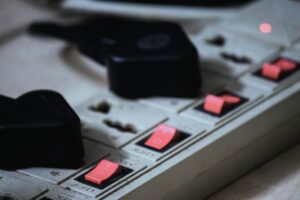It might seem possible, but can you plug a surge protector into an extension cord? Is it safe to do so?
On paper, yes, you can plug a surge protector into an extension cord. Ensure the extension cord can handle the same electrical load as the surge protector. It would also be better if it could handle more. However, this practice is inadvisable. Do not leave the surge protector plugged in for too long if you need to. Extension cords, by design, cannot handle huge loads.
Read on to learn if you can plug a surge protector into an extension cord. More importantly, you will also know if it is safe to do so.
Can You Plug a Surge Protector into an Extension Cord?

Is it safe to plug a surge protector into an extension cord? Technically, it is. This means you can do the plugging of a surge protector into the cord.
However, plug a surge protector into an extension cord only if the latter can handle the same amount of current as the former. If possible, the extension cord should be able to handle more.
Check the extension gauge to determine if your extension cord can handle the surge protector. Being aware of that can also give you an idea about the maximum amperage that it can handle.
For instance, if your surge protectors use 16ga wire, the extension cord should also use the same gauge wire.
What if you have a 16ga wire on your surge protector, but the extension cord uses 14ga only? Then it could be dangerous to use them together.
The extension cord wire can’t handle the same electrical load as the surge protector. This may cause it to heat up considerably. In short, it will turn into a severe fire hazard.
One reason why you should not do this is that it loosens the extension cord’s connection. Also, you are putting a lot of stress on the extension cord. If it fails, it might lead to a fire.
Is an Extension Cord Different from a Surge Protector?
Although they look almost identical, extension cords and surge protectors do not serve the same purposes. As the name suggests, a surge protector protects your electronic devices from sudden power spikes.
These power spikes usually happen when the power suddenly comes on after an outage. This could also happen during storms and lightning strikes.
However, power surges are completely random. They might even occur even in the absence of the situations mentioned above.
Extension cords, also called power extenders, are simply for providing power to an appliance. The appliance must be far from a wall outlet for its power cord to reach.
Extension cords also come in handy when you need additional outlets temporarily and there are no available wall outlets nearby.
Can You Plug an Extension Cord Into Another Extension Cord? Is It Safe?
As mentioned earlier, you can technically connect two extension cords with the surge protector and extension cord. However, safety experts do not recommend this practice.
An extension cord can only be long until it provides too much electrical resistance. The reason is the length of the wire that electricity has to pass through.
When you connect too many extension cords, also called “daisy-chaining,” you risk underpowering your appliances or devices. This is not safe at all.
In addition, daisy-chaining extension cords add more failure points to the circuit. This is why OSHA and other workplace safety agencies advise against doing this.
Instead of connecting several extension cords, do yourself a favor. Buy an extension cord that is the right length for your needs.
Can You Plug a Surge Protector Into Another Surge Protector? Is It Safe?
Out of all the combinations mentioned, connecting two surge protectors is the most dangerous. Did you run out of outlets in one surge protector? Then adding another one on top of it is a bad decision. Instead of doing this, plug another surge protector into another wall socket.
The electrical resistance of one surge protector is already high. This means that daisy-chaining another one will increase the resistance significantly.
In addition, adding another one will significantly affect the efficiency of the first surge protector. This could even get so bad that both surge protectors will not be able to do their respective jobs.
In addition, even the manufacturers of surge protectors would void your warranty if you daisy chain them.
When dealing with something as dangerous as electricity, take as many precautions as possible. If you are daisy-chaining extension cords, ensure they will only be temporary. Get one that is the right length. It should also have a good rating.
What Devices Should You Plug Into a Surge Protector?

After reading all, you might be a bit nervous about using your surge protectors and extension cords. However, you don’t need to be. If you are using them properly, those devices can help quite a lot.
To determine if you are using your surge protector correctly, here are some appliances you can plug into it:
1. Lamps
Lamps are not just for lighting up rooms. They can also serve as decorative pieces. However, finding a place to set up your lamp and have an available power outlet can be difficult. If this is the case, you can use a surge protector.
Even if you need to plug in two or three lamps, your surge protector will do just fine. Lamps are low-energy appliances. They draw very little in terms of electrical current.
Two or three lamps plugged into the same surge protector will not be enough to overload it. They will not also be enough to trip the fuse.
2. Laptops or Computers
Computers are the devices that surge protectors were made for. This is also how people market them when personal computers become a thing. It only takes one bad electrical surge to fry the internal components of your thousand-dollar rig.
Aside from that, you will be losing all your important files. This is why it is essential to always have backups at the ready.
Yes, a surge protector will not prevent your desktop PC from turning off due to a sudden power outage. Despite that, it will still protect it from the surge that will surely follow.
You only have to worry about your PC turning off and losing your unsaved work. You have an assurance that the device will still turn on afterward.
Unless you use a high-end gaming PC, your desktop computer is not using that much power. Even with a power supply rating of 800 watts, it only draws around 250 watts with normal use. This is still within the range of most surge protectors.
3. Smartphone and Tablet Chargers
You likely have at least one phone charger plugged into your surge protector. This is fine because smartphone chargers do not consume that much power anyway.
Typically, they only use around 3 watts of power, and the fast chargers use 33 and 60 watts. These are still relatively low. That amount of electrical load will not be able to trip the fuse.
Again, can you plug a surge protector into an extension cord? You can plug a surge protector into an extension cord. But, ensure that the extension can handle the same or more load as the surge protector.
What Should Not Be Plugged Into a Surge Protector?
There are indeed lots of appliances that you can plug into a surge protector. Note, though, that despite being truly useful, there are also devices you should not plug into them. Do not plug anything that draws huge wattages from the outlet into surge protectors.
Here are some of the things that you should never plug into a surge protector:
1. A Surge Protector
As mentioned multiple times earlier, you should never daisy-chain surge protectors. It is dangerous to do so that it bears repeating. Do not plug one surge protector into another one.
2. Hairdryers, Irons, and the Like
Essentially, do not plug any appliance that heats up into surge protectors. Hairdryers, hair irons, and curling irons all have heating elements.
They also use a lot of power, so much so that they might trip the fuse of the surge protector. Since hair dryers are a no-go, you should not plug electric stoves into surge protectors.
3. All Kitchen Appliances
It does not matter if the appliance is small or big. Never plug them into a surge protector. All kitchen appliances draw so much power that they would be too much for most surge protectors. As much as possible, plug them directly into a wall outlet, especially for larger appliances.
4. Sump Pump
Not only do sump pumps draw a lot of power, but they also work in water. When it comes to appliances near water, you should never use surge protectors. You always have to use a grounded wall outlet.
5. Portable Air Conditioners and Space Heaters
Space heaters create heat, so you know that they draw a lot of power. Although it works the opposite way, portable air conditioners also draw much power. This power is way too much for a regular surge protector. This is why cassette air conditioners need their wall outlet and fuse.
How Surge Protectors Work
The surge protector guards against the damage from sudden electrical surges caused by power outages or thunderstorms. A surge protector works by pulling current from the wall outlet. It then passes it to the devices plugged into it.
Surge protectors contain a metal oxide varistor (MOV). It works by diverting extra voltage away from the appliances plugged into them.
Think of the MOV like it is a pressure-sensitive valve. When the MOV detects unusually high voltage levels, it reduces its resistance to allow it to pass.
Meanwhile, if the voltage seems too low, it will increase its resistance to increase the current. The MOV will immediately work to redirect excess voltages away from the plugged appliances, thus protecting them.
Speaking of the MOV, it has three components. These include metal oxide connected to the power source and the ground line by two semiconductors.
The two semiconductors have variable resistances that cause electrons to move a certain way. This is to change the overall resistance of the surge protector in case of an extremely high or low voltage.
What Is the Difference Between Power Strips and Surge Protectors
Although they look alike, power strips and surge protectors are quite different. Both these items provide additional multiple outlets. However, only the surge protector prevents damage caused by power surges.
Meanwhile, a power strip is typically just a low-cost way to expand the capability of your wall outlet. Sometimes, power strips come with their circuit breaker and on/off switch. However, it will not stop power surges.
Frequently Asked Questions (FAQs)

Should You Plug a TV Into a Surge Protector?
Ideally, yes, but it is not a solid requirement. Desktop computers are not the only electronic devices that can benefit from the protection provided by surge protectors.
Your precious 50-inch smart TV, for instance, should be plugged into a surge protector. This is to guard against the uncertainties brought about by power surges.
Should I Turn Off My Surge Protector at Night?
Although designed to prevent fire hazards, surge protectors still consume electricity even when not in use. Because of that, surge protectors can potentially turn into fire hazards themselves.
So, you should unplug your surge protectors when not in use, especially if you leave the house for extended periods.
Will a Surge Protector Stop Lightning?
Surge protectors provide a certain level of protection against lightning strikes. However, using them alone cannot protect your devices from such a strong electrical current. The only way to ensure that you protect your appliances from lightning strikes is to unplug everything.
In Closing – Is Plugging a Surge Protector into an Extension Cord Safe?
Technically speaking, it is possible. You can plug a surge protector into an extension cord. However, the extension cord should be able to handle the same electrical load (or more) that the surge protector can.
However, even though it is possible, it is not safe and inadvisable. If you have no other choice, you can do this but ensure that it will only be temporary. Remember that extension cords can’t handle large electric loads, especially for a long time.


![Honda GCV160 Spark Plug [6 Best] Honda GCV160 Spark Plug](https://homecarezen.com/wp-content/uploads/2021/11/Honda-GCV160-Spark-Plug-150x150.jpg)
![Read more about the article Red Wire for Ceiling Fan [How to Wire]](https://homecarezen.com/wp-content/uploads/2021/10/red-wire-for-ceiling-fan-300x200.jpg)


